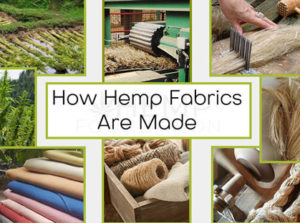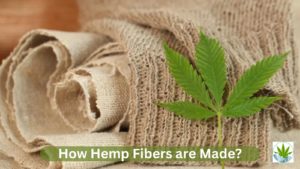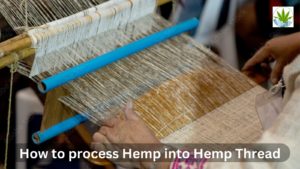Could the hemp plant revolutionize and reshape the fashion industry? Many experts seem to think so.
More than 300,000 tonnes of used clothes end up in landfills or are burnt in the UK. To compound the problem, most of these clothes have never been worn or sold. In most cases, burning and dumping used clothes in landfills is the manufacturers’ and retailers’ way to get rid of “deadstock” in a “cost-effective” way.
For instance, did you know that Polyester clothing takes almost 200 years to decompose fully? Two whole centuries to completely degrade, and yet we pump out tonnes of polyester clothing and dump it even faster.
But, the reality is dawning on many that fashion isn’t just about having more clothes but being socially and environmentally responsible.
In recent years, the fashion industry has become detrimental to the environment, bearing significant responsibility for carbon emissions. It is believed that the industry is the second-worst polluter after oil.
The world needs ways of tackling any form of pollution that accelerates climate change. As the fashion industry moves towards sustainability, the hemp plant is emerging as a more sustainable fashion option.
What is Hemp?
The hemp plant has been used in the textile industry for thousands of years. This biodegradable fabric is becoming popular with major fashion brands looking to add it to their clothing lines.
It could well shape the talk on sustainable fashion as it is an environmentally conscious material for everyday clothing. It is durable, long-lasting, and has a comfortable feel to it. There are many ways hemp rivals clothing made from cotton, whose impact on the planet is far much worse.
Hemp clothing is no doubt going to be a game-changer in the fashion industry, and numerous reasons point to this:
Eco friendly
The Hemp plant is environmentally friendly and does more in developing the climate as opposed to damaging it. It uses very little water compared to cotton. It also does not require pesticides or fertilizers to grow. In the same way, hemp helps restore and detoxify soil as opposed to cotton, which robs the soil of nutrients.
While hemp requires half the amount of land cotton needs to grow, it yields 3 times more fiber than its counterpart. Industrial hemp plants have also been proven to absorb more carbon dioxide from the environment than trees.
Soft and comfortable
Hemp fabric is comfortable and naturally soft on the skin. The material ages beautifully and gets comfortable with time, unlike other clothing fibers.
The more you wash hemp clothing, the softer it becomes while retaining its strength and durability. Therefore, you don’t have to worry about your clothes getting ripped after a few runs in the dryer. They’ll only get gentler and softer as you wear them.
Good for the soil
Unlike cotton, hemp helps enrich the soil while retaining its fertility and preventing erosion. The plant is deep-rooted, thus enabling aeration and allowing constant improvement of soil structure.
Hemp is also a durable rotation crop meaning it can be grown on the same soil a couple of times, further increasing its sustainability.
Contains Antimicrobial properties
Hemp textile is naturally antimicrobial and anti-bacterial, which helps fight the growth and spread of bacteria.
These properties also mean that the fabric is mold and mildew resistant, meaning your clothes maintain a fresh smell for a longer time.
Breathable and insulating
Not many natural materials will provide both cool and insulating properties during all seasons, like hemp clothing. Its fabrics are cool during summer, allowing your skin to breathe, but at the same time, it keeps you warm during the winter period.
The porous fabric allows breathability making hemp a favorite choice for light clothing items such as t-shirts and pants. Its lightweight nature makes it ideal for flexibility and comfort.
Easy to grow
Hemp is relatively easy to grow and maintain, making it a great source of fabric. The plant grows rapidly and is said to grow twice as fast as cotton.
The plant grows well almost anywhere in the world, including Europe, Australia, North and South America, and China.
This is beneficial in that transport expenses, and pollution is minimized. In addition, by having hemp close to the source, communities become more self-sufficient and productive.
Durable and sturdy
How many times have you had to contend with a stretched T-shirt after coming out of the wash? Or a pair of jeans that look smaller in size after pulling it out from the dryer? These problems are less likely to occur with hemp-made clothes.
With hemp, you are assured of strong and durable clothing thanks to its high tensile strength that ensures longevity. You can wash your garments repeatedly without worrying about wear and tear.
Also, the fact that it doesn’t stretch like cotton makes it ideal for manufacturing upholstery.
Retains color dyes
How do you feel when colors fade from your clothes? You would want your clothes to look brighter and maintain the same color they were in when first purchased.
That is precisely what to expect with hemp clothing. Its absorbency allows it to dye well and retain color better than cotton. Therefore, frequent washing of hemp-made clothing will not make the colors fade fast.
Whole plant useful
Hemp is a versatile plant whose uses go beyond just clothing. It’s used to make wholesome seed oil for cooking, while its fibers are used in the textile industry.
The crop is also a biomass fuel producer and has shown promising medicinal benefits. All these uses show that hemp is arguably the most sustainable fiber around as no part of the plant goes to waste.
Resistant to UV rays
Stepping out in the sun has never been easier, thanks to hemp fabric. Hemp is highly resistant to ultraviolet (UV) rays, which increase the risk of skin cancer and premature aging on prolonged exposure.It blocks more than 50% of UV rays compared to conventional cotton garments.
You need not worry about getting sunburned as you head out to the pool or on your next hiking trip. The hemp attire will have you covered, quite literally.




